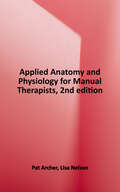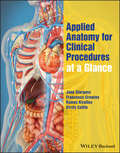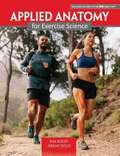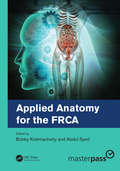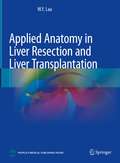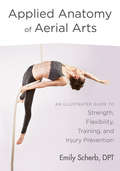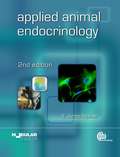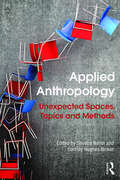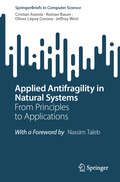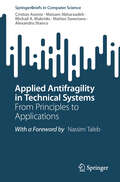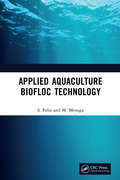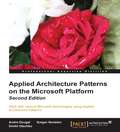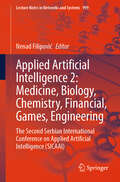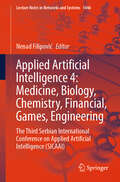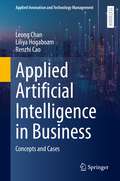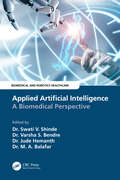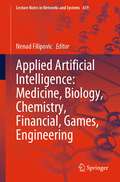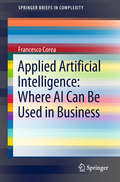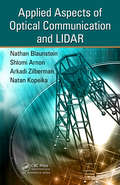- Table View
- List View
Applied Anatomy and Physiology for Manual Therapists
by Lisa A. Nelson Patricia A. ArcherNot many textbooks can make critical anatomy and physiology (A & P) information engaging and accessible for massage therapy learners, but Applied Anatomy & Physiology for Manual Therapists pulls it off beautifully. This premier textbook explores everything manual therapy students need to know about A & P-in ways they can easily understand and apply to their hands-on work. Uniquely relevant and engaging Applied Anatomy & Physiology for Manual Therapists makes A & P principles personally meaningful for students by answering the questions "Why is it critical for me to learn this information?" and "How will it help me become a better manual therapist?" Crucial for safe and informed practice This trusted resource dives deep into need-to-know content, explaining the benefits, effects, indications, and contraindications of specific forms of manual therapy-preparing students to treat clients safely and effectively. <p><p>Practical details to enhance retention of A & P principles: Each chapter contains engaging, classroom-tested content to improve retention of A & P knowledge from classroom to clinic: Manual Therapy Applications highlight subjects most relevant to students' future profession, such as the intricacies of the myofascial network. Pathology Alerts describe common conditions encountered in manual therapy and ways the body systems respond to treatment. BTW boxes contain intriguing A & P facts that deepen students' understanding. What Do You Think? questions bridge the gaps between A & P concepts and manual therapy. Complimentary student resources available. See inside cover for details. Book jacket.
Applied Anatomy for Anaesthesia and Intensive Care
by Andy Georgiou FRCA DICM EDIC FFICM Chris Thompson FRCA EDRA James Nickells Frca Andy Georgiou FRCA DICM EDIC FFICM Chris Thompson FRCA EDRAApplied Anatomy for Anaesthesia and Intensive Care is an invaluable tool for trainee and practiced anaesthetists and intensive care physicians seeking to learn, revise and develop their anatomical knowledge and procedural skills. Concise textual descriptions of anatomy are integrated with descriptions of procedures that are frequently performed in anaesthesia and intensive care, e.g. nerve blocks, focussed echo, lung ultrasound, vascular access procedures, front of neck airway access and chest drainage. The text is supported by over 200 high-quality, colour, anatomical illustrations, which are correlated with ultrasound, fibreoptic and radiological images, allowing the reader to easily interpret nerve block sonoanatomy, airway fibreoptic images and important features on CT and MRI scans. Useful mnemonics and easily reproducible sketch diagrams make this an essential resource for anyone studying towards postgraduate examinations in anaesthesia and intensive care medicine.
Applied Anatomy for Clinical Procedures at a Glance (At a Glance)
by Jane Sturgess Ramez Kirollos Francesca Crawley Kirsty CattleApplied Anatomy for Clinical Procedures at a Glance is a concise resource combining high-quality images and step-by-step instructions to provide expert guidance on the major core training pathways in medicine, surgery and anaesthesia. Written by an experienced team of Foundation Training programme directors and clinical skills examiners, this unique revision and learning guide aligns with training pathways rather than anatomical area to support Foundation doctors and core trainees master these vital clinical procedures. Succinct yet thorough descriptions of each procedure include photographs of surface anatomy, line diagrams of the anatomy, instructions on the procedural techniques, and practical tips for performing the procedures safely whilst minimising risks of complications. All major aspects of Foundation procedures and Core training in applied anatomy are covered, including catheterisation, ECGs, central venous cannulation, basic suturing and anastomotic techniques, endotracheal intubation, epidural injection and spinal injection, defibrillation, and many others. Helps Foundation doctors and Core trainees apply their medical school knowledge in clinical settings Explains the common anatomical pitfalls of invasive clinical procedures Features practice questions on anatomy and clinical aspects to aid in preparing for clinical skills examinations Includes sections on aftercare and on specific equipment, including manometers and underwater seals Applied Anatomy for Clinical Procedures at a Glance is ideal for Foundation doctors and Core trainees, as well as medical students, physician’s assistants and surgical scrub practitioners.
Applied Anatomy for Exercise Science
by Kimberly KeeleyApplied Anatomy for Exercise Science is designed to help students develop foundational knowledge in anatomy and physiology. This textbook is not designed to be an inclusive anatomy and physiology resource, but rather a resource for students to utilize during their first year. Students can use this resource to develop an academic mindset while exploring anatomy and physiology concepts.Applied Anatomy for Exercise Science is divided into two parts: lecture content and a laboratory manual. The lecture content is organised into three sections: (1) Introduction to Applied Anatomy, (2) Musculoskeletal System, and (3) Cardiorespiratory System. Each chapter includes relevant content followed by an outline for note taking and worksheets to gauge understanding of essential concepts. The laboratory manual is divided into seven labs and includes resources for students to learn selected bony landmarks and the action, origin, and insertion of 60 muscles. The lab manual also includes worksheets and illustrations to help students gain a deeper understanding of the muscles and bones included in the textbook.
Applied Anatomy for the FRCA
by Bobby Krishnachetty and Abdul SyedApplied Anatomy for the FRCA covers the anatomical knowledge that trainee anaesthetists who are revising for the Primary and Final FRCA exams will need. The topics covered are derived from the FRCA curriculum and include the most up-to-date version of past exam questions, in order to ensure targeted and successful exam revision. The content, illustrations and overall layout of this book ensure that common gaps in anatomical knowledge encountered by FRCA trainees are included. This reference is divided into sections pertaining to anatomical regions: head and neck, thorax, abdomen, spine, and the upper and lower limbs. The topics of importance to anaesthetists are presented under ‘structures’, ‘circulation’ and ‘nervous system’ (with relevance to regional anaesthesia). Each topic is extensively researched and presented in a simple format for maximum retention. This book makes learning and remembering applied anatomy as straightforward as possible. Applied Anatomy for the FRCA supplements the knowledge required by trainee anaesthetists appearing for the FRCA exams. Clinical educators will also find it useful in teaching. It serves as a practical reference for anatomical knowledge at any point in an anaesthetist’s career. About the Editors Dr Bobby Krishnachetty has been a Consultant Anaesthetist at Southend University Hospital since 2010 and a college tutor for six years. She completed her diploma in medical education and is the author of The Final FRCA Structured Oral Examination: A Complete Guide. She is also the organiser of the regional teaching for Core trainees in the East of England school of anaesthesia, as well as Founder of the ‘Southend Viva Club’ Primary and Final FRCA SOE revision courses for more than nine years, and Cofounder of MRCS OSCE webinars. Mr Abdul Syed has been a Consultant Surgeon at Southend University Hospital since 2015. He is Lead for postgraduate teaching of surgical trainees, Cofounder of MRCS OSCE webinars and conducts Core surgical trainee interview skills courses. Mr Syed is also an Assessor for medical school interviews and an active participant in QI projects and research.
Applied Anatomy in Liver Resection and Liver Transplantation
by W.Y. LauThis book has 20 chapters which cover a full range of knowledge about liver anatomy before one embarks on carrying out a liver operation on a patient. The knowledge ranges from external to internal anatomy of the liver, from pure anatomy to its application in liver operations, from vascular infiow/outflow of the liver to techniques used in reducing intraoperative blood loss, from Couinaud's liver segments to segment- based liver resection, and from the different approaches to liver resectional techniques to the different types of liver transplantation. The particular feature of this book is the heavy use of diagrams which makes reading easier. Surgeons in liver resection and liver transplantation in will find this book of value as a reference book.
Applied Anatomy of Aerial Arts: An Illustrated Guide to Strength, Flexibility, Training, and Injury Prevention
by Emily ScherbAn illustrated guide to anatomy and biomechanics for aerialists who want to optimize their performance and train safelySpecifically designed for aerialists—including those who do trapeze, silks, and other aerial arts— Applied Anatomy of Aerial Arts is an invaluable resource for those who want to optimize their performance and train safely. Using a biomechanical and movement-based approach, Emily Scherb—a physical therapist who specializes in the care, treatment, and education of circus performers—explains the anatomical rationale for progressions of learning and demonstrates simple movements to achieve the coordination, muscular control, strength, and fitness to hang with correct form, how to progress from hanging into a pull up, an inversion, and beyond with a strong center, precise muscle sequencing, and ease of movement. Aerialists will learn how bones, joints, muscles, and soft tissues allow for specific movements and gain an appreciation for concepts of proximal stability. This full-color illustrated guide lays a solid foundation for beginners and advanced students with a wealth of insights into their own performance as well as refreshers on fundamentals in warm ups and conditioning. It explains how to structure a training session, how to care for injuries, and best practices for basic self first aid.
Applied Animal Endocrinology
by E. James SquiresThis textbook explains the role of hormones in improving and monitoring the production, performance, reproduction, behaviour and health of animals. With its focus on livestock animals: cattle, pigs, sheep and horses as well as poultry and fish; the book uses an integrative approach to cover endocrine concepts across species. This updated edition is expanded to include new topics in each section, with updated references, revised study questions and an expanded subject index. It is an essential text for students in animal and veterinary sciences as well as those in academia and industry that are interested in applications of endocrinology in animal production systems. Praise for the first edition: '...a useful text for teaching purposes and an important reference for those who seek ready access to information on specific aspects of applied endocrinology.' Poultry Science
Applied Animal Endocrinology
by E. James SquiresThis book explains the role of hormones in improving and monitoring the production, performance, reproduction, behaviour and health of livestock animals, focusing on cattle, pigs, sheep, horses, poultry and fish. Beginning with the principles of endocrinology and the methods to study endocrine systems, it then covers the different endocrine systems that affect different aspects of animal production and describes how these systems can be manipulated or monitored to advantage. The mechanism of action is covered, and common mechanisms and themes highlighted in order to understand potential methods for altering these systems, and stimulate ideas for the development of new methods. A refreshed, updated resource that highlights new areas of endocrinology with applications in commercial animals, additions to this new edition include: - information on G protein receptors, function of CREB, methods for identification of DNA regulatory sequences and DNA binding proteins, circadian rhythm and the biological clock; - expanded coverage of in vitro models to include 3D cell culture and organ-on-a-chip; - new knowledge on gene editing, antibody production, hormone delivery methods and DNA cloning and sequencing methods; - the role of the gut microbiome, as well as effects of antibiotics and antimicrobials; - skin as an endocrine organ and related information on wool production and endocrine defleecing; - updated information on protocols for assessing endocrine disruptor chemicals. An invaluable text for students of animal science and veterinary medicine, this book also provides a useful resource for those in academia and industry interested in applications of endocrinology in animal production systems.
Applied Anthropology in Canada
by Edward J. HedicanAnthropologists are often reluctant to present their work relating to matters of a broad social context to the wider public even though many have much to say about a range of contemporary issues. In this second edition of a classic work in the field, Edward J. Hedican takes stock of Anthroplogy's research on current indigenous affairs and offers an up-to-date assessment of Aboriginal issues in Canada from the perspective of applied Anthropology. In his central thesis, Hedican underlines Anthropology's opportunity to make a significant impact on the way Aboriginal issues are studied, perceived, and interpreted in Canada. He contends that anthropologists must quit lingering on the periphery of debates concerning land claims and race relations and become more actively committed to the public good. His study ranges over such challenging topics as advocacy roles in Aboriginal studies, the ethics of applied research, policy issues in community development, the political context of the self-government debate, and the dilemma of Aboriginal status and identity in Canada. Applied Anthropology in Canada is an impassioned call for a revitalized Anthropology - one more directly attuned to the practical problems faced by First Nations peoples. Hedican's focus on Aboriginal issues gives his work a strong contemporary relevance that bridges the gap between scholarly and public spheres.
Applied Anthropology: Tools and Perspectives for Contemporary Practice
by Alexander M. ErwinAn invaluable resource for any reader of anthropology, this practical book answers the question, What can I do with a degree in Anthropology? The most up-to-date and accessible book on the subject, Applied Anthropology provides the skills, perspectives, and methodologies needed when working in today's communities and organizations. In addition to a focus on method, this book provides readers with a solid foundation in the history, activities, and ethical concerns of applied anthropology. The book stresses decision-making and the need to understand policy through anthropological analysis. Because an anthropologist must communicate effectively with the general non-anthropological public, the book employs an accessible, jargon-free writing style. Seventeen case studies plus many real-world examples of anthropological practice reinforce the usefulness of in the real-world anthropology. For anyone interested in pursuing a career in anthropology.
Applied Anthropology: Unexpected Spaces, Topics and Methods
by Sheena Nahm and Cortney Hughes RinkerThis collection brings together recent innovative work in applied and practicing anthropology. Organised around the theme of unexpectedness, it examines some of the novel spaces, topics, and methods that anthropologists are involved with. The volume emphasises non-traditional settings and demonstrates the important role of anthropology in addressing some of the pressing issues facing society today. The contributors offer detailed ethnographic examples from their own research and work that give students valuable insight and advice. Drawn mainly from the United States, the case studies illustrate the diverse arenas in which anthropologists operate, from law and finance to education and health care. Simultaneous consideration is given to practical applications, theoretical reflections, and professional experiences.
Applied Antifragility in Natural Systems: From Principles to Applications (SpringerBriefs in Computer Science)
by Roman Bauer Cristian Axenie Oliver López Corona Jeffrey WestAs coined in the book of Nassim Taleb, antifragility is a property of a system to gain from uncertainty, randomness, and volatility, opposite to what fragility would incur. An antifragile system’s response to external perturbations is beyond robust, such that small stressors can strengthen the future response of the system by adding a strong anticipation component. Such principles are already well suited for describing behaviors in natural systems but also in approaching therapy designs and eco-system modelling and eco-system analysis. The purpose of this book is to build a foundational knowledge base by applying antifragile system design, analysis, and development in natural systems, including biomedicine, neuroscience, and ecology as main fields. We are interested in formalizing principles and an apparatus that turns the basic concept of antifragility into a tool for designing and building closed-loop systems that behave beyond robust in the face of uncertainty when characterizing and intervening in biomedical and ecological (eco)systems. The book introduces the framework of applied antifragility and possible paths to build systems that gain from uncertainty. We draw from the body of literature on natural systems (e.g. cancer therapy, antibiotics, neuroscience, and agricultural pest management) in an attempt to unify the scales of antifragility in one framework. The work of the Applied Antifragility Group in oncology, neuroscience, and ecology led by the authors provides a good overview on the current research status.
Applied Antifragility in Technical Systems: From Principles to Applications (SpringerBriefs in Computer Science)
by Matteo Saveriano Cristian Axenie Meisam Akbarzadeh Michail A. Makridis Alexandru StancuThe book purpose is to build a foundational knowledge base by applying antifragile system design, analysis, and development in technical systems, with a focus on traffic engineering, robotics, and control engineering. The authors are interested in formalizing principles and an apparatus that turns the basic concept of antifragility into a tool for designing and building closed-loop technical systems that behave beyond robust in the face of uncertainty. As coined in the book of Nassim Taleb, antifragility is a property of a system to gain from uncertainty, randomness, and volatility, opposite to what fragility would incur. An antifragile system’s response to external perturbations is beyond robust, such that small stressors can strengthen the future response of the system by adding a strong anticipation component. The work of the Applied Antifragility Group in traffic control and robotics, led by the authors, provides a good overview on the current research status.
Applied Approaches to Societal Institutions and Economics: Essays in Honor of Moriki Hosoe (New Frontiers in Regional Science: Asian Perspectives #18)
by Tohru Naito Woohyung Lee Yasunori OuchidaThis book gives readers the theoretical and empirical methods to analyze applied economics. They are institutional economics, information economics, environmental economics, international economics, financial economics, industrial organization, public economics, law and economics, and spatial economics. Because the chapters of this book deal with current topics in these categories, they are relevant not only to researchers and graduate students but also to policy makers and entrepreneurs. As there is uncertainty about the global economy, it is necessary to consider optimal, efficient behavior to survive in the confused world. The book is organized in three parts. Part 1 deals with institutional economics, information economics, and related topics, approached through game theory. Part 2 focuses on environmental economics, international economics, and financial economics, through a microeconomic or econometric approach. Finally, Part 3 concentrates on public economics, social security, and related fields, through microeconomics or macroeconomics.
Applied Aquaculture Biofloc Technology
by S. Felix M. MenagaThe intent of this book is to provide a detailed and specific set of guidelines for both aquapreneurs and researchers related to the application of Biofloc Technology in aquaculture. This book discusses key issues related to both adoption and practices for aquaculture businesses, how to monitor and assess quality and quantity of biofloc, and how to manage the microbial composition and sludge reduction risk in the fish and shrimp culture. The book works through the specific application of disease management and feed management tools for aquaculture from the perspective of this technology. Particular attention is paid on comparing the prototypes of floc development and evaluation on its efficacy in aquaculture. Note: T&F does not sell or distribute the hardback in India, Pakistan, Nepal, Bhutan, Bangladesh and Sri Lanka.
Applied Architecture Patterns on the Microsoft Platform
by Mike Sexton Richard Seroter Rama Ramani Stephen W. Thomas Ewan FairweatherThe book consists of a set of business scenarios and corresponding solution critiques. Each "use case" chapter is made up of a problem description, assessment of implementation options, and the selection of the ideal solution candidate. We then construct the solution using the chosen Microsoft technology.This book is for architects, developers, and managers who need to improve their knowledge of the Microsoft application platform. This book will appeal to anyone who wants to get up to speed on selecting the most appropriate platform for a particular problem. Consultants and executive leadership will also find significant value in this book. A good understanding of the general Windows platform and development technologies would be helpful.
Applied Architecture Patterns on the Microsoft Platform Second Edition
by Dmitri Olechko Gregor Noriskin Andre DovgalPresented in a scenario-driven tutorial way, we lead you through fictitious example problems and present you with the best solutions. This book is intended for architects, developers, and managers who need to improve their knowledge of the Microsoft application platform. This book will appeal to anyone, especially consultants, who want to get up to speed on selecting the most appropriate platform for a particular problem. A good understanding of the general Windows platform and development technologies would be helpful.
Applied Artificial Intelligence 2: The Second Serbian International Conference on Applied Artificial Intelligence (SICAAI) (Lecture Notes in Networks and Systems #999)
by Nenad FilipovićThe book Applied Artificial Intelligence 2: Medicine, Biology, Chemistry, Financial, Games, Engineering is providing exceptional chapters of the state-of-the-art research knowledge and results on the innovative theories, methodology and applications of artificial intelligence and its sub-domain like deep learning, machine learning in different areas such as medicine, economy, education, law, smart city, government, industry etc. Innovative research ideas on how to solve problems using artificial intelligence, both in R&D and real-time applications are presented. Chapters describe the advanced prototypes, systems, methodologies, tools and techniques and general survey papers, which indicate future directions. These Chapters are extended papers from the Second Serbian International Conference on Applied Artificial Intelligence (SICAAI), which was held in Kragujevac, Serbia, on May 19-20, 2023
Applied Artificial Intelligence 4: The Third Serbian International Conference on Applied Artificial Intelligence (SICAAI) (Lecture Notes in Networks and Systems #1446)
by Nenad FilipovićThe book covers the state-of-the-art research knowledge and results on the innovative theories, methodology and applications of artificial intelligence and its sub-domain like deep learning in different areas such as medicine, economy, education, law, smart city, government, industry etc. Moreover, the book aims to provide a platform for researchers and practitioners for both academia and industry to share the information about cutting-edge developments in the field of artificial intelligence. The chapters in this book integrated approach toward global exchange of information on technological advances, scientific innovations and the effectiveness of various regulatory programs toward AI application in medicine, biology, chemistry, financial, games, law and engineering. Real examples from academia and industry give beyond state of the art for application of AI in different areas. These chapters are extended papers from the Third Serbian International Conference on Applied Artificial Intelligence (SICAAI), which was held in Kragujevac, Serbia, on May 23–24, 2024.
Applied Artificial Intelligence in Business: Concepts and Cases (Applied Innovation and Technology Management)
by Liliya Hogaboam Leong Chan Renzhi CaoThis book offers students an introduction to the concepts of big data and artificial intelligence (AI) and their applications in the business world. It answers questions such as what are the main concepts of artificial intelligence and big data? What applications for artificial intelligence and big data analytics are used in the business field? It offers application-oriented overviews and cases from different sectors and fields to help readers discover and gain useful insights. Each chapter features discussion questions and summaries. To assist professors in teaching, the book supplementary materials will include answers to questions, and presentation slides.
Applied Artificial Intelligence: A Biomedical Perspective (Biomedical and Robotics Healthcare)
by Jude Hemanth Swati V. Shinde Varsha S. Bendre M. A. BalafarThis book explores the advancements and future challenges in biomedical application developments using breakthrough technologies like Artificial Intelligence (AI), Internet of Things (IoT), and Signal Processing. It will also contribute to biosensors and secure systems,and related research. Applied Artificial Intelligence: A Biomedical Perspective begins by detailing recent trends and challenges of applied artificial intelligence in biomedical systems.Part I of the book presents the technological background of the book in terms of applied artificial intelligence in the biomedical domain. Part II demonstrates the recent advancements in automated medical image analysis that have opened ample research opportunities in the applications of deep learning to different diseases. Part III focuses on the use of cyberphysical systems that facilitates computing anywhere by using medical IoT and biosensors and the numerous applications of this technology in the healthcare domain. Part IV describes the different signal processing applications in the healthcare domain. It also includes the prediction of some human diseases based on the inputs in signal format. Part V highlights the scope and applications of biosensors and security aspects of biomedical images.The book will be beneficial to the researchers, industry persons, faculty, and students working in biomedical applications of computer science and electronics engineering. It will also be a useful resource for teaching courses like AI/ML, medical IoT, signal processing, biomedical engineering, and medical image analysis.
Applied Artificial Intelligence: Medicine, Biology, Chemistry, Financial, Games, Engineering (Lecture Notes in Networks and Systems #659)
by Nenad FilipovicThe book is covering knowledge and results in theory, methodology, and applications of artificial intelligence and machine learning in academia and industry. Nowadays, artificial intelligence has been used in every company where intelligence elements are embedded inside sensors, devices, machines, computers and networks. The chapters in this book integrated approach toward global exchange of information on technological advances, scientific innovations, and the effectiveness of various regulatory programs toward AI application in medicine, biology, chemistry, financial, games, law, and engineering. Readers can find AI application in industrial workplace safety, manufacturing systems, medical imaging, biomedical engineering application, different computational paradigm, COVID-19, liver tracking, drug delivery system, and cost-effectiveness analysis. Real examples from academia and industry give beyond state of the art for application of AI and ML in different areas. These chapters are extended papers from the First Serbian International Conference on Applied Artificial Intelligence (SICAAI), which was held in Kragujevac, Serbia, on May 19–20, 2022.
Applied Artificial Intelligence: Where AI Can Be Used In Business (Springerbriefs In Complexity Ser.)
by Francesco CoreaThis book deals with artificial intelligence (AI) and its several applications. It is not an organic text that should be read from the first page onwards, but rather a collection of articles that can be read at will (or at need). The idea of this work is indeed to provide some food for thoughts on how AI is impacting few verticals (insurance and financial services), affecting horizontal and technical applications (speech recognition and blockchain), and changing organizational structures (introducing new figures or dealing with ethical issues). <P><P> The structure of the chapter is very similar, so I hope the reader won’t find difficulties in establishing comparisons or understanding the differences between specific problems AI is being used for. The first chapter of the book is indeed showing the potential and the achievements of new AI techniques in the speech recognition domain, touching upon the topics of bots and conversational interfaces. The second and thirds chapter tackle instead verticals that are historically data-intensive but not data-driven, i.e., the financial sector and the insurance one. The following part of the book is the more technical one (and probably the most innovative), because looks at AI and its intersection with another exponential technology, namely the blockchain. Finally, the last chapters are instead more operative, because they concern new figures to be hired regardless of the organization or the sector, and ethical and moral issues related to the creation and implementation of new type of algorithms.
Applied Aspects of Optical Communication and LIDAR
by Nathan Blaunstein Shlomi Arnon Natan Kopeika Arkadi ZilbermanExploring the practical aspects of atmospheric optical communication and light detection and ranging (LIDAR), Applied Aspects of Optical Communication and LIDAR details the role of atmospheric structures in propagation phenomena that influence the transmission of optical signals through perturbed atmospheric communication channels. It examines nume
